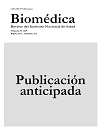HCoV-NL63 and HCoV-HKU1 seroprevalence and its relationship with the clinical features of COVID-19 patients from Villavicencio, Colombia
Abstract
Introduction. Due to the cross-reactivity between SARS-CoV-2 and common human coronaviruses (HCoV), previous infections with these could contribute to serological and/or cellular cross-protection against COVID-19 severity. However, the protective immunity may not develop, or the pre-existing immunity could lead to COVID-19 severity.
Objective. To determine the seroprevalence of IgG antibodies against HCoV-NL63 and HCoV-HKU1 and correlate its previous exposure with the signs of COVID-19 patients from Villavicencio.
Materials and methods. A cross-sectional retrospective study was conducted. ELISA technique was used to search for IgG antibodies against HCoV-NL3 and HCoV-HKU1 in patients who had positive RT-qPCR results for SARS-CoV-2. Patients were grouped according to clinical characteristics features of COVID-19 in four groups: Group 1: asymptomatic (n=23); Group 2: hospitalized (n=24); Group 3: intensive care units (n=24); and Group 4: dead (n=22).
Results. The overall seroprevalence of IgG antibodies against HCoV was 74,2% (n = 69; [95% CI:65,3–83,1]), with 66,7% of HCoV-NL63 (n = 62; [95% CI:57,1–76,2]) and 25,8% of HCoV-HKU1 (n = 24; [95% CI:16,9–34,7]). Based on crosstab analysis, prior exposure to HCoV-NL63 was associated with protection against severe COVID-19 (p = 0,042; adjusted OR = 0,159 [95% CI:0,027–0,938]) and previous coinfection of HCoV-NL63 and HCoV-HKU1 was considered a positive association for severe COVID-19(p = 0,048; adjusted OR = 16,704 [95% CI:1,020–273,670]).
Conclusion. To our knowledge, this is the first study addressing the seroprevalence of HCoV IgG antibodies in Colombia and Latin America. Previous exposure to HCoV-NL63 could protect against severe COVID-19, whereas patients with underlying HCoV-NL63 and HCoV-HKU1 coinfection could be hospitalized with severe signs of COVID-19.
Downloads
Some similar items:
- María-Cristina Navas , Juan D. Cerón, Wbeimar Aguilar-Jiménez , María T. Rugeles, Francisco J. Díaz , Outbreak report of SARS-CoV-2 infection by airborne transmission: Epidemiologic and molecular evidence , Biomedica: Vol. 43 No. 1 (2023)
- Fernando Antonio Messina, Andrés Benchetrit, Andrea Bocassi, María de las Mercedes Romero, Sofía Bauer, Emmanuel Marín, Facundo Bertera, Guillermo Onis, Matías Enzenhofer, Milagro Sánchez, Lilia Mammana, Dana Mijalovsky, Gabriela Santiso, Meningeal cryptococcosis and SARS-CoV-2 infection in people living with HIV/AIDS , Biomedica: Vol. 43 No. Sp. 1 (2023): Agosto, Micología médica
- Karen Feriz, Maria B. Iriarte, Oscar Giraldo, Luis G. Parra -Lara, Veline Martinez, Maria A. Urbano, Guillermo Guzman, Clinical outcomes in patients with diabetes and stress hyperglycemia that developed SARS-CoV-2 infection , Biomedica: Vol. 44 No. Sp. 1 (2024): Enfermedades crónicas no transmisibles
- Julián Alfredo Fernández-Niño , Andrés Cubillos-Novella, Ietza Bojórquez , Michael Rodríguez , Recommendations for the response against COVID-19 in migratory contexts under a closed border: The case of Colombia , Biomedica: Vol. 40 No. Supl. 2 (2020): SARS-CoV-2 y COVID-19
- Juan Pimentel, Neil Andersson, Chloroquine and its derivatives in the management of COVID-19: A scoping review , Biomedica: Vol. 40 No. Supl. 2 (2020): SARS-CoV-2 y COVID-19
- Claudia Milena Cuéllar-Segura, Lessons learned in public health from COVID-19: A look towards future epidemics and pandemics , Biomedica: Vol. 42 No. Sp. 2 (2022): Covid-19
- Jorge Alonso Rivera , Sheryll Corchuelo , Edgar Alberto Parra , Eugenio Aladino Meek, Marcela Mercado, Orlando Torres-Fernández, Inmunohistochemical detection of pandemic SARSCoV- 2 antigens in lung tissue , Biomedica: Vol. 42 No. Sp. 2 (2022): Covid-19
- Jorge Rivera , Sheryll Corchuelo, Julián Naizaque, Édgar Parra, Eugenio Aladino Meek, Diego Álvarez-Díaz, Marcela Mercado , Orlando Torres-Fernández, Histopathology of COVID-19: An illustration of the findings from fatal cases , Biomedica: Vol. 43 No. 1 (2023)
- Angela María Londoño, Juan Raúl Castro-Ayarza, Amira Kronfly, Diana Camila Buitrago, Daniel Felipe Samacá, Epidemiology and healthcare resource utilization in atopic dermatitis in Colombia: A retrospective analysis of data from the National Health Registry from 2015 to 2020 , Biomedica: Vol. 43 No. 1 (2023)
- Raúl A. Rojo-Ospina, Marcela Quimbayo-Forero, Arley Calle-Tobón, Sindy C. Bedoya-Patiño, Maribel Gómez, Astrid Ramírez, Johnny Sánchez, Juan F. Silva-Alzate, Carlos J. Montes-Zuluaga, Jorge M. Cadavid, Enrique A. Henao-Correa, Integrated vector management program in the framework of the COVID-19 pandemic in Medellin, Colombia , Biomedica: Vol. 43 No. 1 (2023)
Copyright (c) 2024 Biomedica

This work is licensed under a Creative Commons Attribution 4.0 International License.
Funding data
| Article metrics | |
|---|---|
| Abstract views | |
| Galley vies | |
| PDF Views | |
| HTML views | |
| Other views | |


























